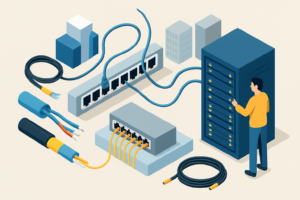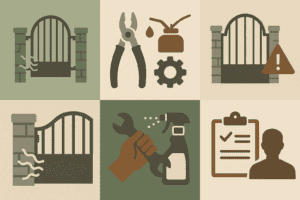
Key Takeaways
- Structured cabling provides a standardized and scalable foundation for efficient, future-ready network communication across all industries.
- Core components like cables, patch panels, and connectors work in harmony to ensure reliable and organized data flow.
- Implementing structured cabling enhances performance, simplifies maintenance, and supports seamless technological expansion.
- Selecting the right cable type—such as Cat6 or fiber optic—depends on performance needs, distance, and future scalability.
- Staying ahead of trends like smart cabling and sustainability ensures networks remain secure, adaptable, and competitive.
Table of Contents
- Introduction to Structured Cabling
- Key Components of Structured Cabling Systems
- Benefits of Implementing Structured Cabling
- Types of Cables Used in Structured Networks
- Role of Structured Cabling in Modern Infrastructure
- Industry Trends and Future Developments
- Challenges and Considerations in Cabling
- Conclusion and Final Thoughts
Introduction to Structured Cabling
Structured cabling is the unsung hero of telecommunications infrastructure, playing an integral role in the seamless operation of networks worldwide. It’s more than just a collection of wires; it’s a meticulously organized system that ensures efficient communication and data transfer across numerous networks. By providing a standardized approach, structured cabling helps to manage complex systems effectively, reducing the likelihood of errors and downtimes. For those seeking more specific elements, such as backbone cabling, you will find essential information on how these elements are vital to supporting expansive communication networks.
The importance of structured cabling extends beyond just operational efficiency. Its design considers the future, allowing for system upgrades and integration with new technologies without the need for complete overhauls. This foresight makes structured cabling an invaluable ally in environments where technology evolves swiftly, ensuring that communication backbones can support growing demands and innovative applications in the ever-expanding digital landscape.
It forms the foundation of digital transformation in both public and private sectors. As businesses increasingly rely on interconnected systems, having a stable and scalable cabling infrastructure becomes crucial. Structured cabling lays the groundwork for adapting to upcoming innovations like 5G and edge computing.
Key Components of Structured Cabling Systems
At the heart of every structured cabling system are several key components, each serving an integral function in the larger framework. These include cables, patch panels, and connectors, all of which ensure seamless data transmission. Cables, often the most visible component, are the physical conduits through which data travels. They come in various types, each suited to specific needs and environments. Patch panels, on the other hand, simplify cable management by organizing connections into a centralized location, making it easier to monitor and handle complex networks.
Connectors establish the vital links between different parts of a network, ensuring that data flows efficiently and securely. Each component of structured cabling is designed to work in harmony with the others, resulting in a robust and resilient network infrastructure. This synergy is essential for managing today’s complex and data-driven business environments effectively.
When these components are selected and installed properly, they minimize signal loss and maximize reliability. Investing in high-quality cabling materials can significantly extend the system’s lifespan. Each element should be evaluated not just for compatibility but also for long-term performance and scalability.
Benefits of Implementing Structured Cabling
The adoption of structured cabling brings a host of benefits, acting as an asset for any organization aiming to maintain efficient and future-proof communication systems. Simplified maintenance is one major advantage, as it allows network issues to be resolved more quickly and efficiently, minimizing downtimes and disruption. This straightforward troubleshooting capability is crucial for maintaining business continuity.
Another significant benefit is enhanced performance, achieved through structured cabling’s ability to support high-speed data transfers with minimal interference and noise. This characteristic ensures that communication remains reliable even as data loads increase. Moreover, the scalability of structured cabling systems allows businesses to expand their networks without substantial infrastructure changes, accommodating growth and technological advancements seamlessly.
A well-planned cabling system also reduces energy consumption and operational costs over time. It enhances workplace safety by minimizing tangled or exposed wiring. Ultimately, it provides a solid return on investment through reliability, speed, and adaptability.
Types of Cables Used in Structured Networks
Structured networks employ various types of cables, each tailored to specific performance requirements and operational contexts. The most usual types include Cat5e, Cat6, and fiber optic cables, each offering unique advantages. Cat5e cables are known for their cost-effectiveness and ability to support performance demands in home and small office environments. Cat6 cables, while more expensive, provide faster data rates and improved bandwidth, making them ideal for medium to large-sized networks where higher-capacity data transfers are necessary.
Fiber optic cables stand out because of their exceptional speed and resistance to electromagnetic interference, making them the go-to choice for long-distance and high-capacity network links. Their capacity to transmit data over vast distances with minimal signal degradation is invaluable, especially in large enterprise environments where data integrity and speed are paramount.
Choosing the right cable depends on the environment, budget, and future bandwidth needs. As data requirements continue to increase, fiber optics are becoming the preferred option for mission-critical systems. Proper installation and testing are essential to maximize the potential of each cable type.
Role of Structured Cabling in Modern Infrastructure
In today’s interconnected world, structured cabling systems are foundational to supporting diverse infrastructures, including data centers, smart buildings, and city-wide networks. By ensuring robust and reliable connectivity, structured cabling facilitates the smooth operation of various technology-driven systems and applications. It enables the handling of large volumes of data produced by modern IT environments, supporting both routine business operations and innovative technology deployments.
This capability makes structured cabling an indispensable part of modern digital infrastructure, allowing businesses and communities to harness the power of technology for enhanced efficiency, productivity, and sustainability. As the demand for data-driven solutions continues to grow, the role of structured cabling in providing the necessary connectivity will only become more pronounced.
Its integration with automation, cloud services, and IoT has further elevated its importance. From healthcare to transportation, structured cabling supports mission-critical communication in nearly every industry. A reliable cabling foundation ensures uninterrupted services and a better user experience.
Industry Trends and Future Developments
The structured cabling industry is witnessing rapid evolution, with exciting new trends paving the way for future developments. Sustainability and energy efficiency are among the key trends as organizations aim to reduce their carbon footprint while maintaining high performance. There is also a significant movement towards integrating advanced technologies like IoT and AI into cabling systems. According to ZDNet, these innovations are transforming structured cabling into more intelligent and responsive networks that are capable of anticipating and adapting to changing demands dynamically.
Such advancements highlight the importance of staying informed about industry trends to make timely and strategic decisions regarding infrastructure investments. As these technologies become more mainstream, those who adapt early will likely gain significant competitive advantages.
Emerging standards will further influence cable types, installation practices, and energy management. Proactive organizations are already piloting smart cabling systems for predictive maintenance and real-time monitoring. Staying ahead of these trends ensures both resilience and relevance in a rapidly changing tech landscape.
Challenges and Considerations in Cabling
Despite its many advantages, structured cabling is not without its challenges. Keeping pace with rapid technological changes requires continuous updates and adaptations to infrastructure, which can be resource-intensive. As cyber threats rise, ensuring network security alongside structured cabling is another critical challenge, demanding vigilant strategies and practices to protect sensitive data.
Moreover, maintaining compliance with industry standards is vital for ensuring network integrity and reliability. Failure to adhere to these standards can lead to inefficiencies and increased vulnerabilities. Addressing these challenges proactively can help organizations maintain robust and secure networks capable of supporting their long-term strategic goals.
Working with certified professionals helps ensure installations meet both current and future requirements. Budgeting for routine audits and upgrades can prevent costly overhauls down the line. A strategic approach to cabling can mitigate risks and optimize long-term infrastructure performance.
Conclusion and Final Thoughts
Structured cabling is an indispensable element of modern communication systems, providing the foundational support required for the demands of technologically advanced infrastructures. Its standardized and efficient nature empowers organizations to leverage technology effectively. According to insights from TechCrunch, investing in forward-thinking strategies and innovations is crucial for keeping structured cabling relevant and effective amid continuous technological advancements.
By understanding the intricacies of structured cabling and staying aligned with industry developments, businesses can ensure their communication networks remain robust, secure, and adaptable, ready to meet future challenges and opportunities head-on.
In an increasingly connected world, structured cabling is no longer a luxury—it’s a necessity. Organizations that prioritize this infrastructure will gain an edge in agility, performance, and security. The future of communication depends on the strong foundations laid today.













